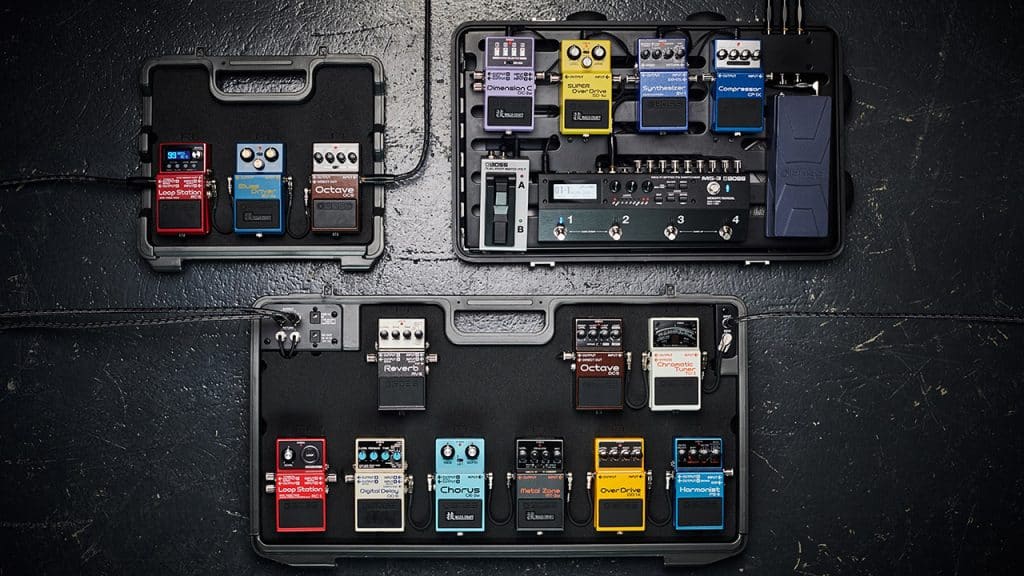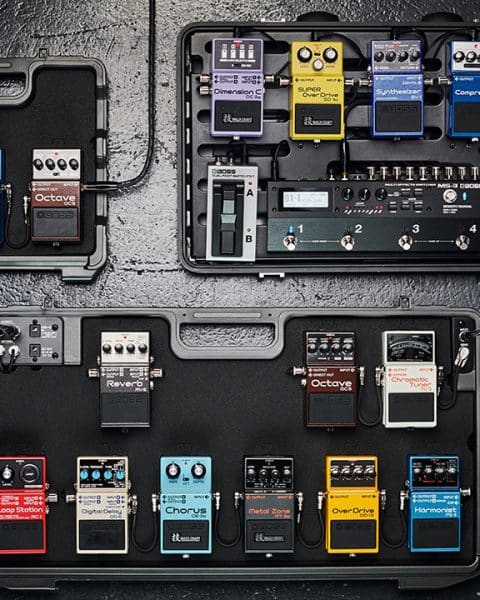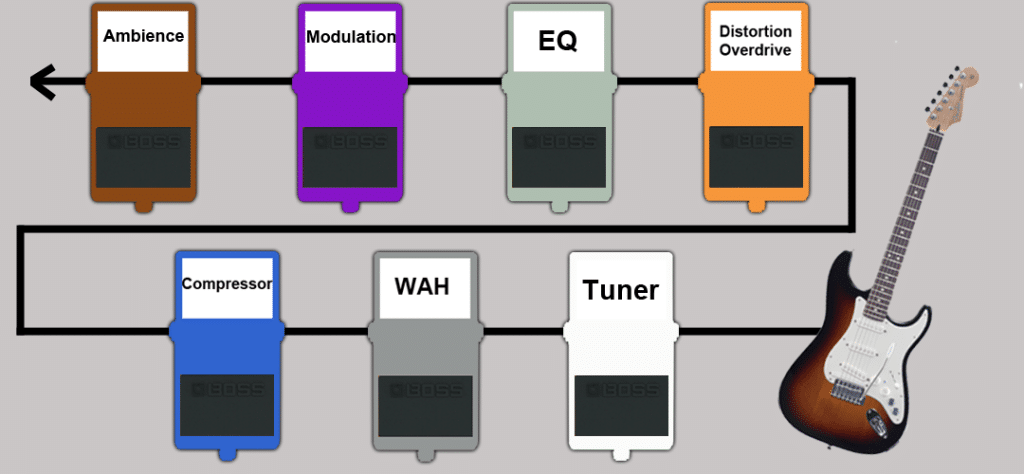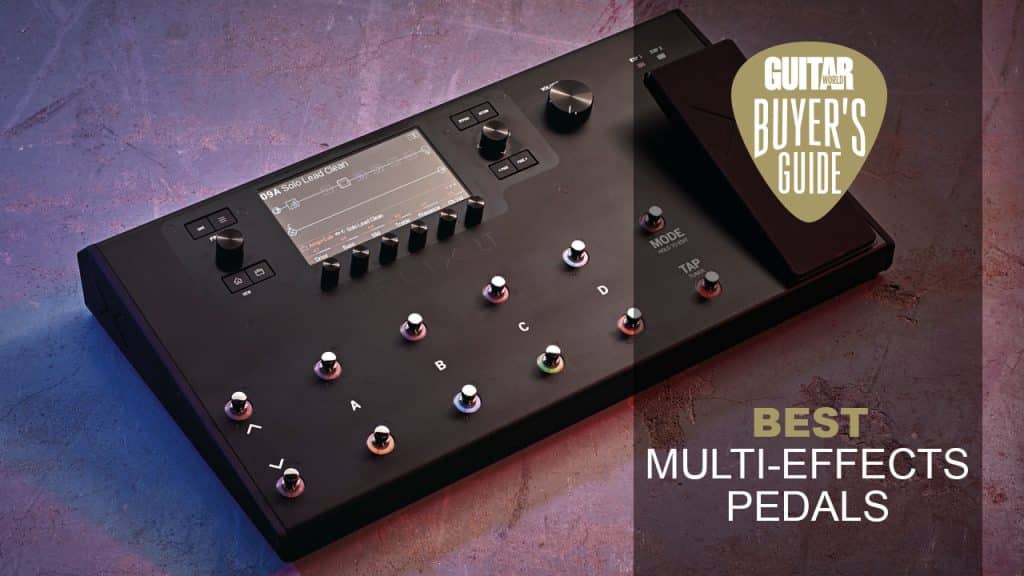Are you a guitar enthusiast looking to take your playing to the next level? Look no further than the ultimate guide to finding the best guitar multi effects pedal. Whether you’re a seasoned musician or just starting out, this article will provide you with all the information you need to make an informed decision. Discover the top brands, features to consider, and tips for getting the most out of your pedal. Say goodbye to boring, one-dimensional guitar tones and hello to a world of endless possibilities. Get ready to unleash your creativity and elevate your sound with the best guitar multi effects pedal.
Understanding Guitar Multi Effects Pedals
What is a guitar multi effects pedal?
A guitar multi effects pedal is a device that combines multiple guitar effects into a single unit. Instead of purchasing separate pedals for each effect, a multi effects pedal allows you to access a wide range of effects such as distortion, delay, reverb, modulation, and more, all in one convenient package. These pedals typically feature built-in footswitches, knobs, and a display to control and customize the effects.
Why use a guitar multi effects pedal?
There are several advantages to using a guitar multi effects pedal. First and foremost, it offers convenience and saves valuable space on your pedalboard. Instead of carrying around multiple pedals, you can have all the effects you need in one compact unit. This is especially beneficial for gigging musicians who need to transport their gear efficiently.
Additionally, a multi effects pedal provides versatility and flexibility in shaping your guitar tone. With a wide array of effects at your fingertips, you can experiment with different sounds and create unique sonic textures. Whether you’re going for a vintage, classic rock tone or a modern, high-gain metal sound, a multi effects pedal allows you to explore and dial in your desired tone effortlessly.
Lastly, a multi effects pedal is cost-effective. Purchasing individual pedals can be expensive, especially if you’re aiming to achieve a diverse range of sounds. Investing in a quality multi effects pedal can save you a significant amount of money compared to buying each effect separately.
Types of guitar multi effects pedals
There are generally two types of guitar multi effects pedals: floor-based and rack-mounted.
Floor-based multi effects pedals are the most common and user-friendly option. They are designed to be placed on the floor and operated with your feet while performing. These pedals typically have a durable construction and are built for live use. They are an excellent choice for guitarists who need quick access to their effects during a performance.
On the other hand, rack-mounted multi effects pedals are designed for studio use and are often found in professional recording setups. These pedals are typically mounted in a rack and are controlled through a MIDI controller or a computer software. Rack-mounted multi effects pedals offer more advanced features and greater control over your effects but are less portable and require more technical knowledge to operate.
When choosing between the two types, consider your usage and whether you prioritize live performance or studio recording.
Factors to Consider When Choosing a Guitar Multi Effects Pedal
Budget
First and foremost, establish a budget for your multi effects pedal. Prices for multi effects pedals can vary greatly, ranging from affordable options to high-end, professional-grade units. Determine how much you are willing to spend and look for pedals within that price range. Keep in mind that higher-priced pedals often offer more advanced features and better sound quality, but this may be unnecessary if you’re a beginner or on a tight budget.
Sound Quality
The sound quality of a multi effects pedal is paramount. After all, the main purpose of the pedal is to enhance your guitar tone. Look for pedals that offer high fidelity and accurate representations of the different effects. Reading reviews and listening to demos can give you a good sense of the sound quality of a particular pedal. Additionally, consider whether the pedal provides customization options to tailor the sound to your liking.
Features
Consider the specific features you require in a multi effects pedal. Some pedals offer a basic set of effects, while others provide a vast library of presets and the ability to create your own custom sounds. Look for pedals that offer the effects you frequently use or would like to experiment with. Additionally, consider features such as built-in tuner, expression pedal input, and the ability to use external footswitches for added functionality.
User Interface
The user interface of a multi effects pedal plays a significant role in its usability. Look for pedals that have an intuitive layout, clear labeling, and easy-to-use controls. Consider the number and layout of footswitches – this determines how easily you can switch between effects during a performance. A well-designed display is also important, as it allows you to navigate menus and make adjustments easily.
Durability
Since multi effects pedals are frequently used on stage and during rehearsals, durability is crucial. Look for pedals that have a sturdy construction, preferably with metal casing. This ensures that the pedal can withstand the rigors of live performances and travel. Additionally, consider the quality of the footswitches, knobs, and buttons – they should be responsive and built to last.
Portability
If you’re a gigging musician, portability is an essential factor to consider. Look for pedals that are lightweight and compact, making them easy to transport. Some pedals even come with carrying cases or bags for added convenience. Consider the power requirements of the pedal as well – if it can be powered by batteries or has a built-in power supply, it offers more flexibility in different performance settings.
Different Types of Effects
Overdrive/Distortion
Overdrive and distortion effects are perhaps the most commonly used in guitar playing. They add grit, sustain, and harmonics to your tone, ranging from mild overdrive to heavy distortion for genres like rock and metal. Look for multi effects pedals that offer a wide range of overdrive and distortion models to suit your preferred style.
Delay/Reverb
Delay and reverb effects add space and depth to your guitar sound. Delay creates repetitions of your guitar signal, while reverb simulates the sound of playing in different environments such as concert halls or small rooms. Look for multi effects pedals that provide various delay types (such as tape, analog, or digital) and reverb algorithms to achieve the desired ambiance for your playing.
Modulation
Modulation effects include chorus, flanger, and phaser, among others. These effects add movement and richness to your tone by modulating the audio signal. Chorus creates a shimmering, doubled sound, flanger produces a jet-like swoosh, and phaser creates a swirling, psychedelic effect. Look for multi effects pedals that offer a range of modulation effects to experiment with different textures.
Pitch-shifting
Pitch-shifting effects allow you to alter the pitch of your guitar signal. This includes octavers, harmonizers, and whammy effects. These effects can create harmonies, simulate multiple guitar tracks, or provide dramatic pitch bends. Look for multi effects pedals that offer pitch-shifting capabilities if you’re looking to experiment with unique tonal possibilities.
Wah
The wah effect is a classic effect commonly associated with funk and rock guitar playing. It mimics the sound of a wah-wah pedal, allowing you to control the filter sweep manually. Look for multi effects pedals that include a wah effect if you enjoy playing genres that heavily utilize this iconic sound.
Compression
Compression is an effect that evens out the dynamic range of your guitar signal. It boosts quiet notes and reduces the volume of louder notes, resulting in a more consistent and controlled sound. Look for multi effects pedals that offer compression to enhance your playing dynamics and improve sustain.
Noise Gate
A noise gate is an essential tool for eliminating unwanted noise and hum from your guitar signal when you’re not playing. It cuts off the signal when it falls below a certain threshold, ensuring a cleaner and quieter tone. Look for multi effects pedals that include a noise gate to minimize unwanted noise during your performances.
Looping
Looping is a popular feature in multi effects pedals that allows you to record and layer short sections of your playing. This is particularly useful for practicing, songwriting, and creating live loops during performances. Look for pedals that offer looping functionality if you want to explore the creative possibilities of layering and looping your guitar parts.
Expression Pedals
Some multi effects pedals have an expression pedal input, which enables you to control certain parameters in real-time, such as volume, wah, or modulation depth. Look for pedals that offer this feature if you prefer hands-free control over specific effects while performing.
Integration with Amps and Setups
Compatibility with different amplifiers
When choosing a multi effects pedal, consider its compatibility with different amplifiers. Some pedals are specifically designed to work optimally with certain amp models, while others are more versatile and can be used with a wide range of amps. Check the compatibility requirements of the pedal and ensure that it pairs well with your existing gear.
Effects loop or front of the amp
With multi effects pedals, you have the option to connect them either in the effects loop of your amplifier or in front of the amp. Connecting in the effects loop allows you to manipulate the signal after the preamp stage, while connecting in front of the amp affects the tone before it goes through the preamp. Consider your preferred setup and choose a pedal that accommodates your specific setup preferences.
Stereo outputs
If you’re interested in creating a stereo sound or running your guitar signal through multiple amplifiers or speakers, look for multi effects pedals that offer stereo outputs. These outputs split the signal into two separate channels, enhancing the spatial and stereo imaging of your guitar sound. Make sure your pedals and amplifiers are compatible with stereo connections before incorporating this feature into your setup.
User Interface and Accessibility
Number and layout of footswitches
The number and layout of footswitches on a multi effects pedal are important for easy navigation and switching between effects. Consider the number of effects you typically use and choose a pedal that provides enough footswitches to accommodate your needs. Additionally, pay attention to the layout of the footswitches. A well-thought-out layout makes it easier to identify the active effect and switch between them effortlessly.
Display and navigation
A clear and informative display is essential for easily accessing the features and settings of your multi effects pedal. Look for pedals that have a bright and easy-to-read screen, allowing you to navigate menus and make adjustments without any difficulties. Touchscreens or color-coded displays can further enhance the user experience and make it more intuitive to use.
Assignable knobs and buttons
Some multi effects pedals feature assignable knobs and buttons, allowing you to assign specific parameters to each control. This gives you greater control over the effects and allows for real-time adjustments during performances. Consider whether you prefer this level of customization and look for pedals that offer assignable controls to suit your playing style.
Presets and customization options
Presets are an invaluable feature in multi effects pedals, especially if you perform different styles of music regularly. Look for pedals that offer a significant number of presets and the ability to store your custom settings. The more presets available, the more versatile your pedal will be, allowing you to switch between different sounds with ease. Customization options such as saving and editing presets directly on the pedal are also worth considering.
Sound Quality and Versatility
Digital vs. Analog
Multi effects pedals can be digital or analog. Digital pedals use digital signal processing to recreate various effects, while analog pedals use analog components to achieve their sound. Digital pedals offer a wide variety of effects, pristine sound quality, and greater flexibility. Analog pedals, on the other hand, often have a warmer and more organic tone but may have fewer options. Consider your preferred sound and tonal characteristics when choosing between digital and analog multi effects pedals.
Effects processing quality
The quality of effects processing in a multi effects pedal greatly impacts the overall sound quality. Look for pedals that use high-quality algorithms and processing chips to ensure accurate and realistic emulations of the effects. Reputable brands often invest in research and development, resulting in top-notch effects processing. Reading reviews and listening to audio demos can give you a good idea of the quality of a particular pedal’s effects.
Realistic emulations
When using multi effects pedals, many guitarists aim to replicate the sound of classic analog pedals or iconic guitarists. Look for pedals that offer realistic emulations of popular effects and tones. Consider whether the pedal’s emulations meet your specific tonal aspirations and if they suit the genres of music you play.
Versatility and flexibility
Multi effects pedals should offer versatility and flexibility in shaping your guitar tone. Look for pedals that provide a wide range of effects, adjustable parameters, and the ability to chain effects together in different combinations. The more tweaking options available, the more creative you can get with your tones. Consider the genres you play and the variety of sounds you aim to achieve when evaluating the versatility of a multi effects pedal.
Connectivity and Integration with other Gear
Input and output options
Consider the input and output options of a multi effects pedal. Check for compatibility with your guitar and amplifier connections. Most pedals have a standard 1/4″ input for guitar input and a 1/4″ output to connect to your amplifier or audio interface. Additionally, look for pedals that offer additional outputs, such as headphone jacks or XLR outputs, for increased connectivity options.
MIDI capability
MIDI (Musical Instrument Digital Interface) capability allows you to control and synchronize your multi effects pedal with other MIDI-enabled devices, such as MIDI switchers, controllers, or computer software. Look for pedals that feature MIDI connectivity if you want to integrate your pedal seamlessly with your existing MIDI setup or control it remotely.
Software integration
Some multi effects pedals offer companion software that allows you to deep-dive into the pedal’s settings and access additional features. Software integration provides a more detailed and visual interface for editing presets, managing effect chains, and exploring new sound possibilities. Consider whether software integration is important to you and choose a pedal that offers this additional functionality.
USB connectivity
USB connectivity is a convenient feature that allows you to connect your multi effects pedal to a computer for firmware updates, recording, or direct integration with recording software. Look for pedals that have USB ports for easy connection and compatibility with your computer setup.
Power supply options
Consider the power supply options for a multi effects pedal. Some pedals are powered by batteries, while others require an external power supply or can be powered via USB. Battery-powered pedals offer greater portability, but you may need to frequently replace batteries. External power supplies provide a consistent power source but require access to power outlets. USB-powered pedals offer versatility and can be powered by other devices such as laptops or USB power banks. Choose the power supply option that best suits your needs and playing situation.
Ease of Use and Learning Curve
Straightforward setup
When choosing a multi effects pedal, consider how straightforward the initial setup process is. Look for pedals that are plug-and-play, requiring minimal configuration to start using them. Additionally, consider how easy it is to integrate the pedal into your existing rig. The simpler the setup process, the quicker you can start unleashing the pedal’s potential.
Intuitive controls
Intuitive controls are crucial for a smooth workflow and hassle-free operation of a multi effects pedal. Look for pedals that have well-designed knobs, buttons, and footswitches that are labeled clearly and logically. This allows for quick adjustment and easy identification of the active effects without confusion or frustration.
Tutorials and support
Some multi effects pedals come with accompanying tutorials or documentation to help you get started and make the most out of the pedal’s features. Consider whether you prefer additional guidance and look for pedals that provide comprehensive tutorials or support resources. This can be particularly helpful if you’re new to multi effects pedals or want to explore advanced features.
Compatibility with existing knowledge
Consider whether the multi effects pedal aligns with your existing knowledge and familiarity with guitar effects. If you are already familiar with specific effect pedal models or have experience with similar multi effects pedals, choosing a pedal that shares similarities in layout or operation can make the learning curve smoother. However, if you’re looking to explore new realms of guitar effects, a pedal that offers unique features and unfamiliar effects might be a better fit.
Reviews and Recommendations
Notable guitar multi effects pedals on the market
When researching multi effects pedals, it’s helpful to explore notable options available on the market. Some popular choices include the Line 6 Helix, Boss GT-1000, Kemper Profiler, Fractal Audio Axe-Fx III, and the TC Electronic G-System. These pedals have gained a reputation for their sound quality, versatility, and user-friendly interfaces.
Expert and user reviews
Reading reviews from both experts and users can provide valuable insights into the pros and cons of different multi effects pedals. Expert reviews often offer in-depth analysis of the pedal’s sound quality, build quality, and overall performance. User reviews, on the other hand, provide real-world experiences and feedback from fellow guitarists who have used the pedals under various conditions. Consider both expert and user reviews to get a well-rounded perspective before making your decision.
Popular recommendations
Seeking recommendations from fellow musicians, music forums, or online communities can be helpful when choosing a multi effects pedal. Often, experienced guitarists or gear enthusiasts can provide personal insights and suggest pedals that have worked well for them. Consider popular recommendations, but also keep in mind that everyone’s preferences and playing styles may vary, so what works for one person may not work for another. It’s important to find a pedal that aligns with your specific needs and preferences.
Conclusion
In conclusion, a guitar multi effects pedal is a versatile and convenient tool for guitarists of all levels. By combining multiple effects into a single unit, the pedal offers convenience, saves space, and provides a vast array of sonic possibilities. When choosing a guitar multi effects pedal, consider factors such as budget, sound quality, features, user interface, durability, and portability. Additionally, evaluate the different types of effects the pedal offers, its integration with amps and setups, user interface and accessibility, sound quality and versatility, connectivity and integration with other gear, ease of use, and learning curve. Researching reviews and recommendations can also help you make an informed decision. With the right guitar multi effects pedal, you can unlock endless creative potential and elevate your guitar playing experience.











